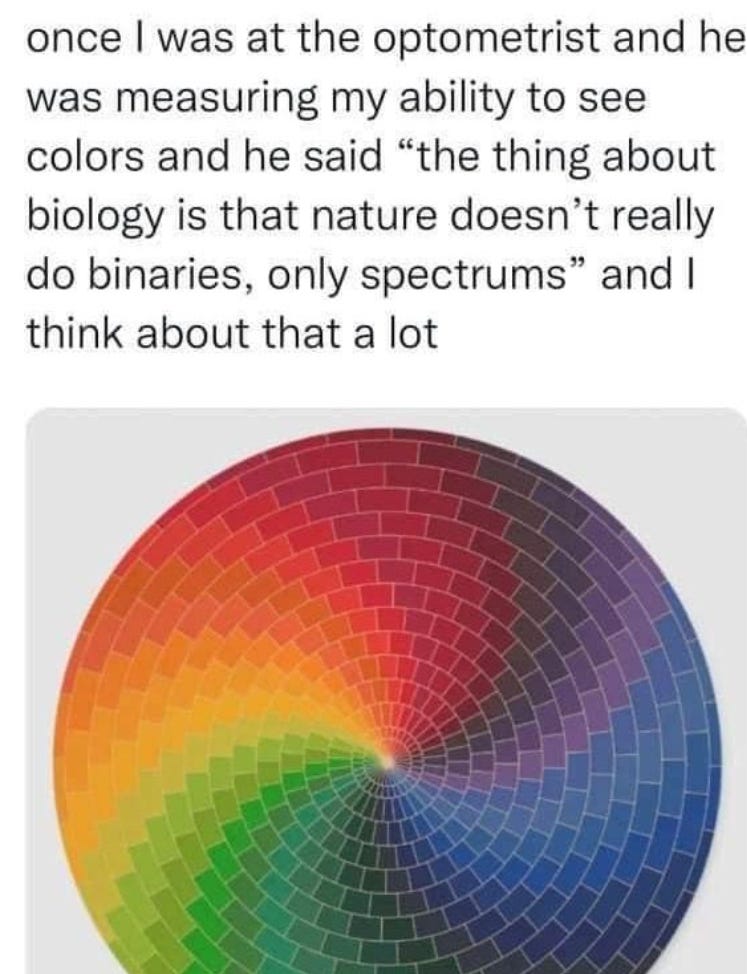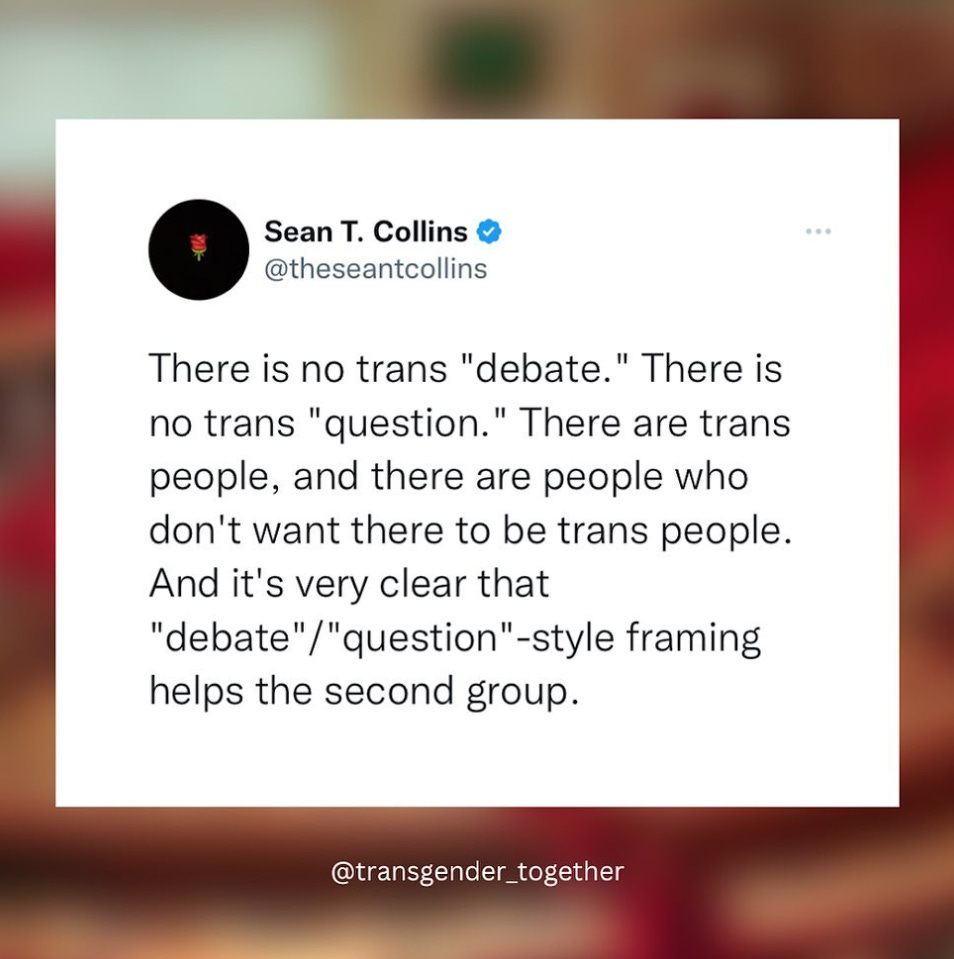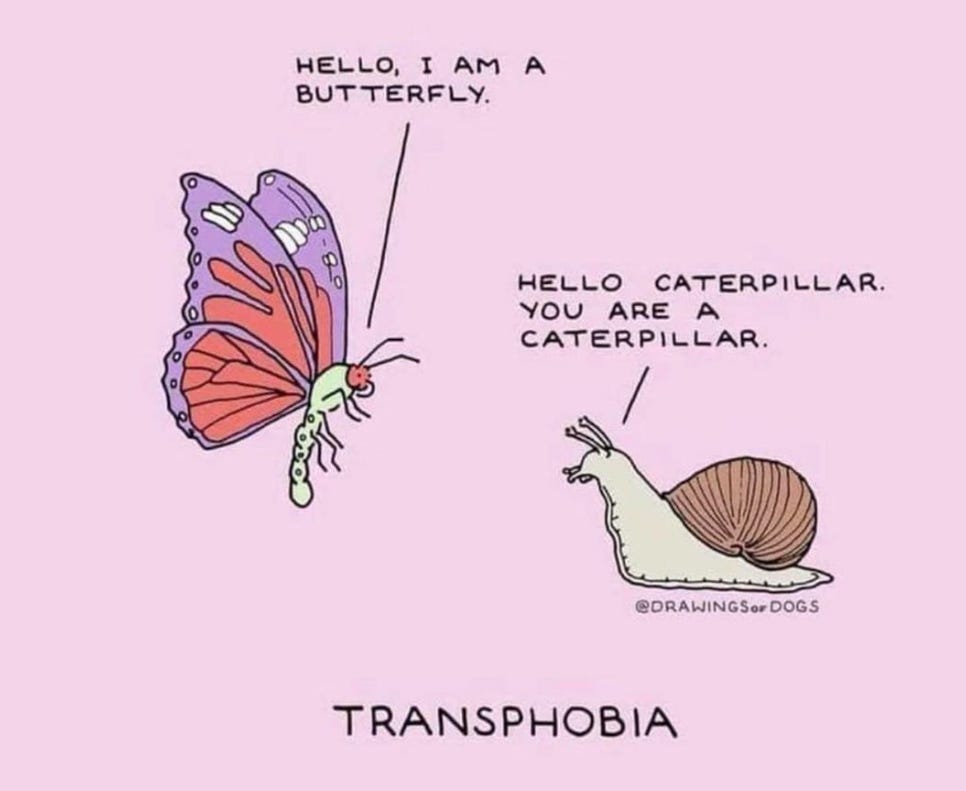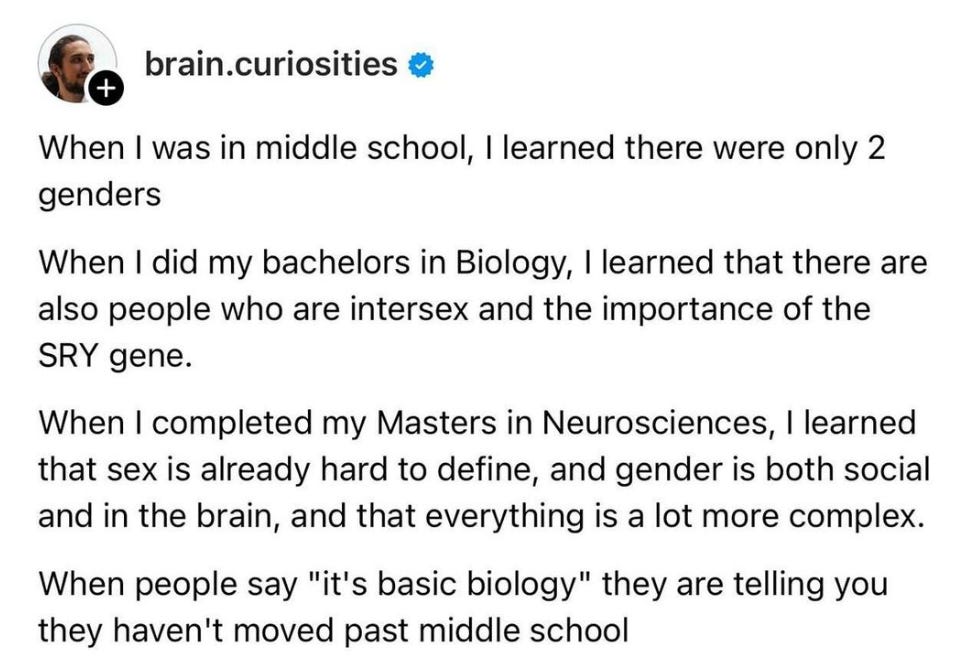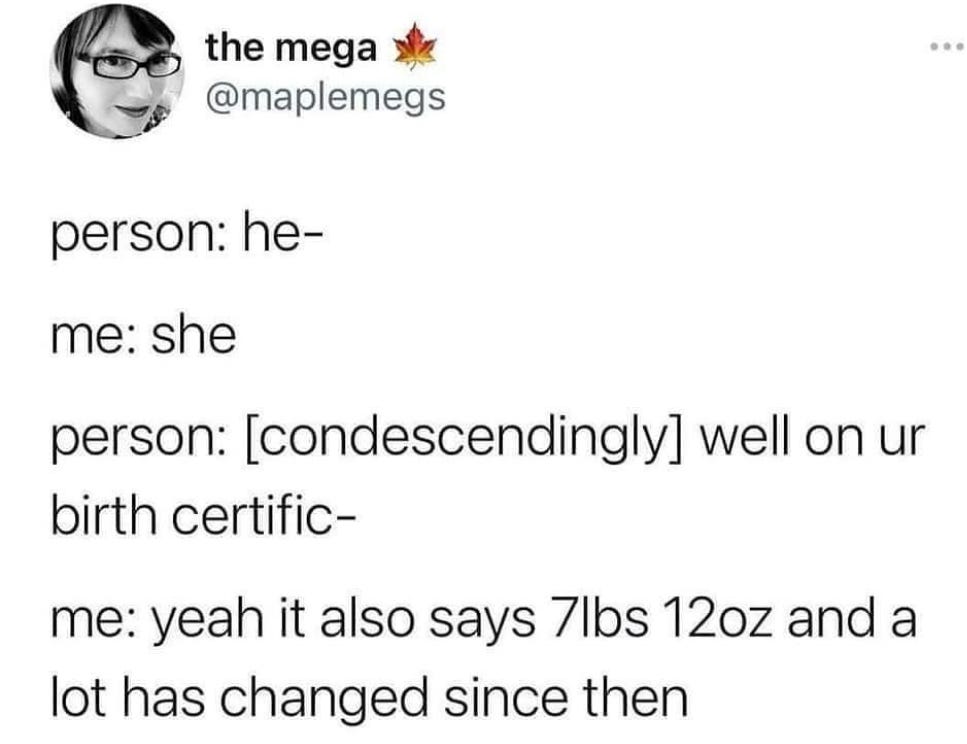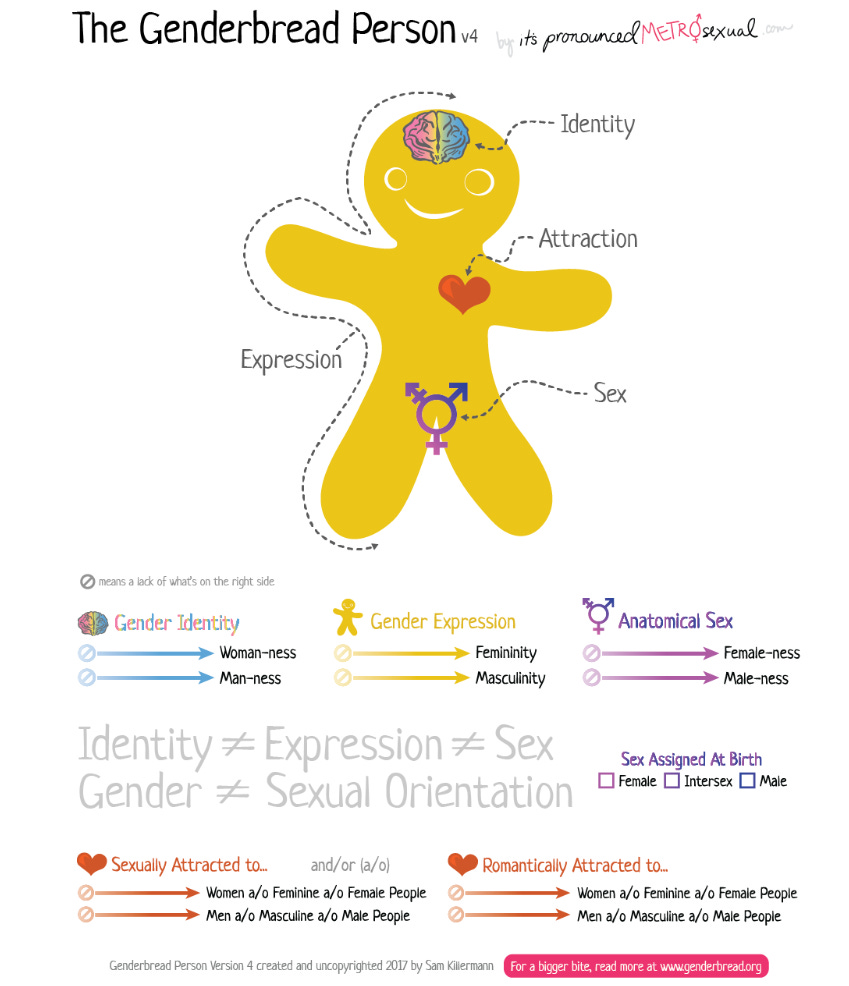(In case you missed it, Part 1 is here)
OK, so today’s post feels reeeeeeaaalllly tricky to me, as I’m trying to walk the narrow and uncomfortable line between “Everyone is human, deserves unconditional acceptance and respect without any need to justify their reality” vs “Here’s some scientific information to support the realities that trans people are living”.
Nobody - absolutely nobody - needs to justify or defend their inner knowing and sense of who they are to anyone else. It’s disrespectful, not to mention arrogant and an act of supremacy, to demand that somebody *prove* that their identity is “correct” or “right”. When any of our friends (cis, het, and non-binary) tell us who they are, our job is to simply believe and joyfully accept them.
So on one hand, this post feels a bit gross and disrespectful to me: I’m using scientific data to “prove” the legitimacy of my trans friends’ identities, when in reality, this is unnecessary because their lives and identities are valid without this.
I’m also hesitant about invoking science to legitimise trans realities because of the sexist and racist history embedded in this kind of mindset and approach.
Historically (particularly in the 19th & 20th centuries), white male scientists were explicitly looking to create and then use the sex binary to justify denying women’s rights on the basis of “nature”. During this time, the term “biological sex” began to be used in order to warrant discrimination against white women, black people, Indigenous people, and people of colour.
Scientists argued that women were “inherently different from men in their anatomy, physiology, temperament, and intellect” and that white women “lagged behind [white] men, much as primitive people lagged behind Europeans” in the civilizational hierarchy. European scientists leveraged the rhetoric of “biology” to naturalize discrimination against women as part of a greater political agenda. This wasn’t legitimate science based on reliable data, but rather was discussed in their research as being “common knowledge”, and was used to deny women’s suffrage as a law of nature instead of the result of political choices.
We see exactly the same thing happening today, where people continue to use the rhetoric of science - not the reality of science - to justify discrimination against trans people.
For a better idea of why this sits in an ugly place, I’d love it if you’d watch this 3-minute video re: brain scans and gender, and the harm that pathologizing gender identity can cause (it’s short and interesting): https://www.cbc.ca/player/play/video/1.7154926
However, since we’re not at a place in society where we allow people to know what they know about themselves without skepticism and judgment, let me make sure we’re on the same page in terms of basic biology and some definitions… and boy-howdy, buckle up, buddies because we’re in for a ride!
Please remember that the following few paragraphs don’t even begin to scratch the surface of the science behind gender/sex; what I’m providing is truly less than a micro-drop in a vast ocean of data. Also, I am not a scientist, so I’m condensing information that was already summarized and put in layman’s terms for non-scientists, which was based on other information that was re-worded for regular folks which was based on actual scientific data and research. So I’m hoping this will be enough to get you started and point you in the direction of being able to find and access solid information.
Brief Biology:
All righty, friends. A wee question for you: at what point did you realize that our grade 9 science classes from back in the day were woefully incomplete in terms of teaching us about gender? For me, that realization came WAY too late in life. Many of us were taught that a person’s sex is strictly binary (male or female, xx or xy chromosomes, penis or vagina), but science has proven time and again that this isn’t true and there’s a lot of complexity and nuance involved (this link is a great place to start in order to understand the bigger picture; I found it absolutely fascinating).
In fact, researchers understand that sex or gender is actually a spectrum trait, and involves a host of genetic, hormonal, neurological, cellular, and developmental factors. Let me give you just one teeny detail from each of the first 3 of those categories that (in my opinion) begin to show how inadequate binary gendering really is.
Let’s briefly look at chromosomes: Did you know that 99.9% of human genomes are identical? Yet there’s a pervasive and erroneous belief that males and females are genetically distinct and opposite. When you look at the history of genetic research, scientists were initially hesitant to assert that chromosomes were the genetic determinants of sex because there was (and continues to be) woefully little evidence that the presence of the Y chromosome is the mediator of difference between males and females.
If we think about what we might have been taught about hormones, specifically that testosterone is a “male” hormone and estrogen is a “female” hormone, we’ll find that we were misled about this, too. Testosterone is a steroid hormone found across genders and sexes and has multiple functions (including ovulation). It’s found in organs of sex development, but it’s also found in blood, saliva, urine, brain, muscles, skin, and internal organs. It has different expressions in different contexts. All bodies have and use testosterone, and all bodies have and use estrogen.
Neurologically, various studies have been and continue to be conducted to examine human brains to see what can be found in terms of similarities and/or differences between the male and female brain. Overall, as you saw in the video I included earlier in this post, the human brain is an organ in the same way that the heart, kidneys, and lungs are organs; there isn’t a distinct male brain or female brain. However, there do appear to be subtle differences that can be found in some small structures and functions of the brains of males and females. One example is that male and female brains have been found to process smells differently, and when studied using MRI scans, transgender brains align with their experienced gender, not their sex (gender assigned at birth).
(Please note that if you start digging into scientific data re: “male” vs “female” brains, there will be mixed findings, so try to hold the bigger picture of “no human needs to justify their existence but the brain is endlessly enthralling” while you noodle around with the various ideas.)
I do hope, though, that these tiny snippets are enough for you to begin to see that the makings of sex and gender are incredibly complex and multifactorial.
Now let’s look at just a few definitions that will help us in the upcoming posts:
Gender Assigned at Birth (or “sex” of a person): In terms of meaning, this is kind of straight forward in the sense that a person’s gender assigned at birth is based solely on identifying an infant’s genitals. (Aside: in essence, every “gender reveal party” is actually a “genital reveal party”, a fact which makes me giggle a bit.)
Gender Identity: Is a person’s internal sense of being male, female, or - for some people - a blend of both or neither, and is based on an interaction of biological traits, developmental influences, and environmental conditions. This may be male, female, somewhere in between, a combination of both or neither.
Please note that this isn’t just an “inner sense” in a whimsical, transient “Oh, today I think I’m____________ (fill in the blank). It appears that transgender individuals are living with biological contradictions within their own bodies: their genitals may indicate one thing about their gender, but their genetics, hormones, cells, and brain function may indicate different truths about their gender. They and they alone are the ones who are able to determine their gender identity.
Gender Expression: refers to the many ways people show their gender to others, such as the clothing and haircuts they wear or the roles and activities they choose to express who they are.
Gender Dysphoria: is what some (not all) transgender folks may experience, which is significant psychological distress as a result of the incongruence between their sex assigned at birth and their gender identity. It often begins in childhood, but some trans people may not experience it until puberty or later in life.
Cisgender: is the word we use when the gender that a person identifies with matches their genitals as well as their own biology/ physiology, etc. Between 97-99% of people fall into this category.
Transgender: is the word we use when the gender that a person identifies with does NOT match their gender assigned at birth. Transgender people have always existed and have been documented in societies from antiquity until the present day.
Non Binary (NB or “enby”) or Gender Diverse: Describes those who fall outside of the gender identity binary of strictly “male” or “female”. It can mean different things to different people, but it essentially refers to someone whose gender identity can’t be exclusively described as “woman” or “man”. A non binary person may or may not consider themselves to be trans.
Perhaps this graphic helps:
One last detail I’d like to address is: how much of the population is trans?
According to Canada Statistics, approx. 1 in 300 people aged 15 & up are trans, so in a school the size of the SRSS in Steinbach (there were over 2000 students in the 2023-24 school year, so let’s round up to 2100), statistically, there would be 7 trans and/or non-binary kids.
In a global survey conducted in 2023, 3% of respondents from 30 countries identified themselves as transgender, non-binary/non-conforming/gender-fluid, or in another way.
Whew! We did it! That was quite a bit of info, so thanks for sticking with me.
See you in the next post where we’ll talk about how gender identity develops in children.
Sources for this section:
Aside from the hyperlinks, the info in this section mostly came from a variety of “book reports” from Alok Vaid-Menon’s Instagram page, and I’ve linked the books they reported on, along with the dates they were posted below.
Brain Storm: The Flaws in the Science of Sex Differences by Dr. Jordan-Young (Harvard University Press 2011) from @alokvmenon, April 18, 2024
Making Sex: Body and Gender from the Greeks to Freud by Dr. Thomas Laqueur (Harvard University Press, 1990), from @alokvmenon July 20, 2023.
Sex Itself: The Search for Male and Female in the Human Genome by Dr. Sarah S. Richardson (University of Chicago Press 2015). From @alokvmenon April 11, 2024).
Sexual Science: The Victorian Construction of Womanhood by Dr. Cynthia Russett (Harvard University Press 1991) from @alokvmenon, March 24, 2024.
Testosterone: An Unauthorized Biography by Dr. Katrina Karkazis and Dr. Rebecca Jordan-Young (Harvard University Press 2019) from @alokvmenon March 12, 2023.
If you’re curious about learning more about the science of gender, try this video:
And if you’re interested in a very readable/accessible take on research that supports the idea that trans peoples’ brains align with their gender identity, not their gender assigned at birth, this is a great article by Dan Dacombe:
~ K.




